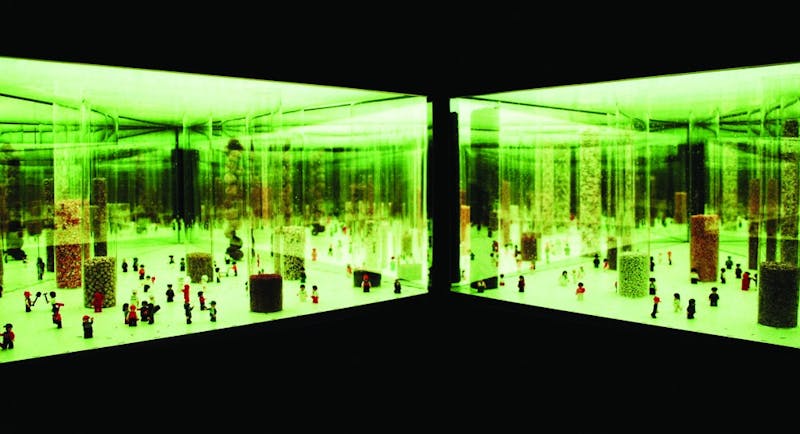
At Diplareios School in Athens, Greece is studio art professor Zenovia Toloudi’s project “Silo(e)scapes,” which is part of the exhibition “Tomorrows: Urban Fictions for Possible Futures,” and is meant to serve as both an art installation and an architectural model. The piece is a model of a small community of people who preserve and tend to their native seeds in a communal space designed for the preservation of native plant species.
The viewer enters the piece from the bottom of the exhibition through a small hole, where they are surrounded by clear columns filled with actual seeds, which are surrounded themselves by small plastic people. The entire project is bordered by mirrors, positioned to make the space appear infinite.
The seeds are ball-like to reference a “near-future,” following the theme of the larger exhibition, which pushes its participants to envision a version of a city in the future, in either a dystopian or utopian fashion. Toloudi said she chose a more utopian future to inspire her viewers.
“Often, when we hear about the big problems of humanity, we feel, as individuals, we don’t have the capacity to change,” she said.
Using a smaller scale, she said she hopes that such solutions will appear more feasible to her viewers, encouraging them to act as individuals.
The close interaction between the viewer and the piece, as well as the figures with the architecture, emphasize much of Toloudi’s work, noted architect Evangelos Kotsioris, who studied with her at the Harvard School of Design.
“She has always been attached to the idea of human engagement in architecture, to things that are usually overlooked in architectural discourse today in favor of larger gestures,” Kotsioris said.
“Tomorrows” itself also departs from certain architectural trends, focusing more on urban and civic planning roles, he said.
“Thinking about the city was very much something that happened in the 1960s and 70s, and there were very many young architects [who] were not interested in buildings but ... in visions and ideas and the larger questions,” Kotsioris said.
Toloudi said her work takes on many of these abstract challenges, not only bringing a solution to an environmental problem, but also touching on cultural connections with food and the importance of community and public spaces. In her native country Greece, like in many parts of the world, the diversity of accessible native fruits and vegetables is dwindling. The exhibition is meant to bring light to this issue, while also presenting the one possible solution of bringing the seed banks, often owned by well-off individuals and major corporations, to the native people of the country.
As a scholar, Toloudi said she is interested in the relationship between architecture and food, having taught several classes on the subject herself. Kotsioris, who was also a guest critic in many of her “Food and Architecture” courses, said that one of the markers of Toloudi’s work is her ability to create “new civic rituals,” such as a seed bank or market, creating a “new exchange of food and knowledge.”
Although food itself is still a large part of Mediterranean culture, the involvement of individuals in the production of food is decreasing, Toloudi said. She also uses her piece to reference the rich culture which came from agriculture, particularly in the sound played in the background of her installation, she said.Music professor Ted Levin, who specializes in ethnomusicology, helped Toloudi select her pieces for the exhibition. As an ethnomusicologist, Levin studies “soundscapes,” or the sound profile of a specific locality. Toloudi herself, Levin said, comes from an area near the city of Thessaloniki, Greece, which is primarily agricultural. Accordingly, she chose sounds from an area north of the region to supplement her piece.
“Music, traditionally, has a very strong relationship with agricultural cycles,” Levin said. “There are calendar songs — songs related to harvests.”
The piece itself also tries to bring architecture back to the creation of something that is connected with the natural world, rather than something which creates great barriers from it, Toloudi said.
“I’m trying to work that relationship so it’s not so exotic and not so unnatural in that way,” she said.
The Lego-like figurines which inhabit the space were also specially selected by Toloudi, who aimed to portray “community workers,” such as nurses, police officers and firefighters. These individuals also reflect a communal focus Toloudi said she intends to bring to the piece.
“This whole focus on the individual, I believe, can be very harmful,” she said.
As an artist, Toloudi said she works to address the issue of social inequality, which she considers to be the largest problems society faces today. One of the solutions to this problem is an increased focus on public spaces, she said.
To create such spaces, Toloudi said she looks back to eras of democracy, noting the design of spaces that have a clear purpose for the public. One of the elements that she uses in these spaces is the column, one of the simplest elements of architecture, whose replication and subsequent elevation to a higher purpose as part of a larger structure is meant to remind the viewer of the role of the individual in a public space.
Looking to environmental issues as well as those of social inequality, Toloudi said she addresses her subject from an intersectional perspective, following in the old tradition of expressing big ideas through architecture.
“As a creator, I have the responsibility to make a response to the problems of my time,” Toloudi said.
Correction Appended (June 24, 2017): A previous version of the June 23 article "Zenovia Toloudi's "Silo(e)scapes" is art and architecture" was updated to state that the exhibition contains real seeds, not plastic balls representing seeds.



